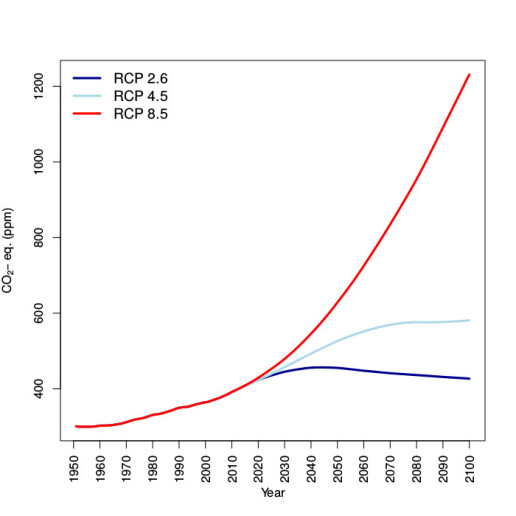You are here: Cordex.be » Simulations » Dynamical regional climate simulations
Dynamical regional climate simulations
The figure below shows the simulations that are performed by the RCM groups. Within the EURO-CORDEX and the CORDEX.be frameworks, two past dynamical downscaling climate simulations and three climate projections will be done by each of the groups:
(A) An evaluation run, with boundary conditions that are provided by the ERA-Interim reanalysis for the period 1981-2010;
(B) A historical run driven at the boundaries by a CMIP5 GCM for the period 1976-2005. The host GCMs for the respective RCMs are listed here; and
(C) Three climate projections based on greenhouse gas emission scenarios (RCPs) corresponding to: rising radiative forcing crossing 8.5 W/m² at the end of 21st century (RCP8.5), stabilization of radiative forcing after the 21st century at 4.5 W/m² (RCP4.5), and peaking radiative forcing within the 21st century at 3.0 W/m² and declining afterwards (RCP2.6) (Moss et al., 2010 and 2008; Nakicenovic et al., 2000; Van Vuuren et al., 2008). All three RCP runs are performed for the periods 2070-2100, 2040-2070 and 2005-2040.

Overview scheme showing the planned simulations within the CORDEX.be project. For each model the preferred sequence of model simulations is 1A, 1B, 1C, 2A, 2B and 2C (RCP8.5→RCP4.5→RCP2.6).
The equivalent CO2 evolution from 1951-2100, as described by the three RCPs, and used for the climate projections, is illustrated in the figure below. Besides the “high” scenarios such as RCP4.5 and RCP8.5, which are very relevant for adaptation planning, it was decided to also include the “low” RCP2.6 scenario in the simulations. The reason for this is that in the context of the Paris Agreement, “low” scenarios such as RCP2.6 are indeed important to evaluate impacts, since scaling of high scenarios is potentially misleading (e.g. Lissner and Fischer (2016)). Moreover, it has become important to distinguish the differences in terms of impact between the 1.5°C and 2°C global warming case and large ensembles are required to increase the ratio between the signal (climate change) and the noise (climate variability) for each case (Mitchell et al., 2016).
The model outputs of this RCM CORDEX.be micro-ensemble are used to drive the Local-Impact Models.

The equivalent CO2 evolution as described by the three RCPs (RCP 2.6, RCP 4.5, RCP 8.5) which are used for the climate projections in the CORDEX.be project.
